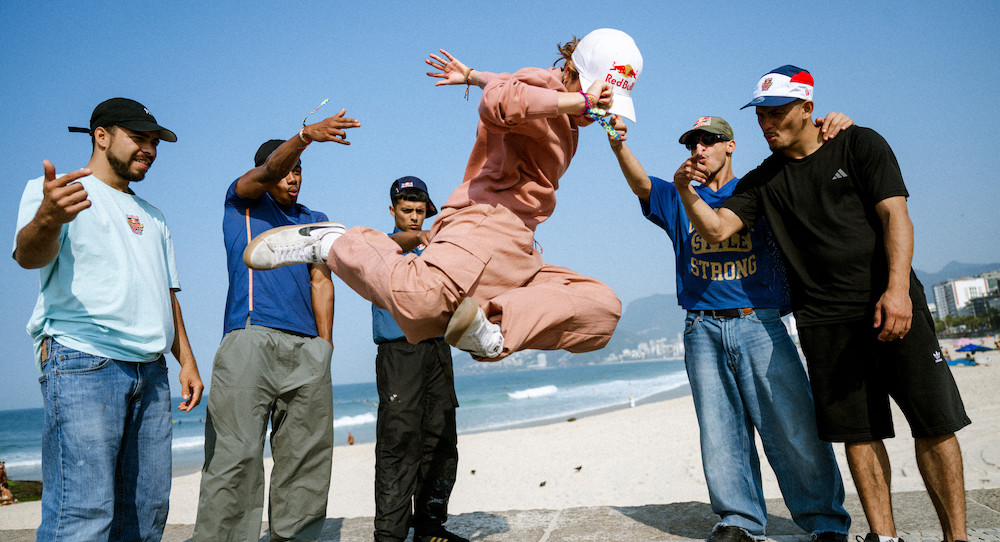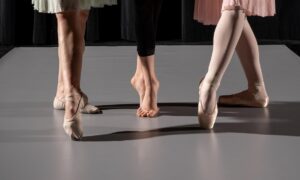The world caught Olympics fever again this summer, as it does every two years. But this year, breaking (what some call “breakdancing”) was part of the excitement. There are many intriguing questions around the style taking the world stage, in the context of sports.
How much is it a sport, and how much is it an art form? Can it be both? How do we effectively and honestly score something subjective? How can we present it all to the world in a way that supports the style and the art form? Breaking competitions are certainly nothing new – but how can they most successfully translate to the Olympic Games?
All of those questions aside, what we saw at the Games was some truly accomplished artistry and athleticism. We at Dance Informa want to shine a light on those who rose to the top, the six medalists — gold, silver, and bronze in the men’s and women’s categories. To be clear, great work wasn’t exclusive to those six competitors.
But let’s take a closer look at them in particular — their background, their work at the Olympics and more. Also to note, after each of the following competitors battled, they embraced. That’s sportsmanship. The medals are great – but the love of the style, of competing, of the community and of continuing to elevate one’s game…that’s what really matters.
Women’s Medalists
Gold: “B-Girl Ami” Ami Yuasa (Japan)
Yuasa, 25, began breaking the way that many dancers begin — in the footsteps of an older sibling. At only six years old, her big sister introduced her to the form and sparked her passion for it. (Her sister still dances, and competes…the two have even competed, and won, together!)
By age 10, she was training hard – even commuting two hours to a train station where a group regularly gathered to practice. She learned from top Japanese breakers such as Katsu-one and Taisuke. In 2018, she won the Red Bull BC One World Final – the first year the competition held a B-Girl category. She won again in 2023. Next stop: the Paris Olympics. After an exciting final with B-Girl Nicka, she clinched the first women’s Olympics breaking gold.
She moves in a notably grounded way, nevertheless with energy continuing to channel up and out. She has satisfying flow even as she executes striking athletics – making her come off as notably human, rather than “dancer.” Perhaps more than any other competitor, she delivers that cliché dance ideal of making it look “easy” when it’s of course anything but. Perhaps that’s why the gold is hers.
Silver: “B-Girl Nicka” Dominique Banevic (Lithuania)
Banevic, only 17, is certainly already making her mark on the breaking world. She discovered the form at only five years old, and has been passionate about it since (training six hours a day, in addition to schoolwork). Banevic believes that age doesn’t matter – what’s important is “how you dance.”
She also underscores the importance of mindfulness in dance and competition, to be “fully in the present moment.” (Banevic also works with a sports psychologist to help her stay mentally grounded.) Authenticity is also key, she believes. Banevic certainly has unique artistry, through both physicality and musicality.
With striking flexibility and plasticity, she moves with a quality that feels elastic – but also eruptive. She fluidly rides the beats of the music at hand, and the momentum moving through her body, to keep it all integrating together. Making the Olympics in 2024 was a key goal of hers, and she’s now done that. She still has years of competing and creating ahead – so the sky’s the limit on what she could achieve from here.
Bronze: “B-Girl 671” Liu Quingyi (People’s Republic of China)
Quingyi, 18, also started breaking at 10 years old. She saw it on the street, became instantly fascinated, and immediately found a studio where she could train. In breaking, she found community and enhanced her confidence. (She says that breaking helped her to be more outgoing and communicative.)
Working with B-Boy Ho and then B-Boy Chao, she started to dominate at national competitions. Quingyi became known internationally first at Slovakia’s Outbreak Europe, then at the Red Bull BC One World Final 2022. In the 2023 competition, B-Girl Ami took the title, yet 671 (how her name is actually pronounced in English) affirmed her status as one of the top female breaking competitors in the world. Paris 2024 came, and the rest is Olympics history.
Her movement is, in a word, explosive — bursting with pure power, sharp articulation of accents and full use of space (more than many other competitors). Her shapes are crisp, but not stuck; she finds that ideal blend of kinetic clarity and continuity. She’s another notably young competitor and artist – so she has years ahead to further refine her craft and keep moving forward.
Men’s Medalists
Gold: “Phil The Wiz” Philip Kim (Canada)
Kim, 27, was another competitor inspired to start breaking after seeing a street battle. With family from Korea, yet raised in Toronto, Canada, he began his breaking journey at 12 years old with the N.O.N. Crew. He went on to learn from breakers such as B-Boy Jugz and Reflex, and to dance with the 7 Commandoz Crew.
He’s built a name as a top global competitor through Red Bull BC One titles in 2017 and 2018, and through the 2023 Pan American Games (Santiago, Chile) – through which he qualified for the 2024 Paris Olympic Games.
Kim dances with a striking blend of accent and suspension: crisp punctuation of movement in quick footwork, and extension of movements as he holds freezes. He creates a superb musicality through how he brings those qualities together. Perhaps that is what the judges saw that had them awarding him the gold; the excitement of dance can be at the intersections of various qualities, the tensions between them.
“It went by very fast…it feels like a dream,” Kim said after clinching the gold. At the top of the field, he continues to believe in continued self-improvement and artistic authenticity.
Silver: “B-Boy Dany Dann” Dany Civil (France)
Civil, 35, hails from French Guiana. He discovered breaking at age 15, and later relocated to mainland France in order to study the form more seriously and to have competitive success (that’s dedication!).
His international titles began in 2018, with competitions such as Battle of the Year, 2022’s European Championships and World Championships, and 2023’s Breaking for Gold series in Brazil. 2024 brought him competing for his adopted home country of France, right in its capital.
Civil moves with beautiful flow, over a foundation of notable strength and control. He navigates smaller, more nuanced movements – closer to his core center (“kinesphere”) – and those that expand farther and faster. All of that comes together to create a style that feels as unique to him as his blue hair and affable smirk. He passes on all of the positivity, individuality, and craft through his organization Best One, which supports young people in learning to break and in reaching their dreams.
Bronze: “B-Boy Victor” Victor Montalvo (USA)
Montalvo, 30, is still inspired by his late mentor B-Boy MexOne. “He really made me believe in myself,” Montalvo says. “I use what he told me until this day.” The Mexican-American b-boy from Florida also followed in the footsteps of his father and uncle, trailblazing breakers in their own right.
In fact, when he won the Red Bull BC One title in 2015, he gave his father his trophy belt. His father had always believed in him, Montalvo said, and – while successful – never quite won at that level. He has said that’s the “most important” title he’s ever won. Does he feel the same after winning the first Bronze in Olympic Men’s Breaking? He may just have the groundedness and heart to have family continuing to mean the most, no matter what happens.
In top rocks, Montalvo weight shifts with a sweet suave and a smooth finesse. In freezes, he creates a seamless channeling of momentum that would inspire envy in many accomplished contemporary dancers. That all comes together to make him highly satisfying to watch – in a way calming, even while he moves with raw power.
By Kathryn Boland of Dance Informa.















